#Thomas Parnell
Explore tagged Tumblr posts
Text







Marbled Monday
This week's example of marbling is used in the binding of Poems by Goldsmith and Parnell printed by W. Bulmer of the Shakespeare Printing Office in 1795. English printer and typographer William Bulmer (1757-1830) established the Shakespeare Press in 1790 and published over 600 volumes during its operation.
Irish poet, novelist, and playwright Oliver Goldsmith (1728-1774) was a poor student but a good writer, especially noted for his pastoral style. English-Irish poet and clergyman Thomas Parnell (1679-1718) is considered one of the "Graveyard Poets," whose work often contained ruminations on mortality and were considered precursors to the Romantic and Gothic movements. Goldsmith wrote a biography of Parnell that was often published with collections of the latter's works.
The binding of this book shows great attention to detail. The marbled paper is, I believe, a Stormont Pattern in red, ten, green, and black. The corners and spine are covered with dark green goatskin featuring gold tooling and the title stamped on the spine. The corners and the edges of the goatskin leather covering the spine have a blind-tooled design on them. It's a very good example of a well-considered and designed binding.
View a post on the wood engravings in this book.
View more Marbled Monday posts.
-- Alice, Special Collections Department Manager
#Marbled Monday#Oliver Goldsmith#Thomas Parnell#William Bulmer#graveyard poets#stormont#stormont pattern#poems#marbling#marbled paper
23 notes
·
View notes
Text
Poem of the Day 21 May 2023
Song by THOMAS PARNELL
WHEN thy beauty appears In its graces and airs All bright as an angel new dropp’d from the sky, At distance I gaze and am awed by my fears: So strangely you dazzle my eye!
But when without art Your kind thoughts you impart, When your love runs in blushes through every vein; When it darts from your eyes, when it pants in your heart, Then I know you’re a woman again.
There’s a passion and pride In our sex (she replied), And thus, might I gratify both, I would do: Still an angel appear to each lover beside, But still be a woman to you.
1 note
·
View note
Text
David Corn at Mother Jones:
It is hardly surprising that a political movement that has as its godhead a convicted felon and inveterate liar who attempted to overturn an election and incited a violent assault on the US Capitol to retain power would within nanoseconds exploit the assassination attempt at a Donald Trump rally that left one attendee dead. But the utter brazenness of this effort has been stunning. Before crucial details were known—who’s the shooter? why did he do this?—MAGA was out in full-force to blame President Joe Biden, Democrats, and progressives for this shooting by stirring up anti-Trump sentiment. Leading the way in unhinged right-wing responses, Rep. Mike Collins (R-Ga.) called for Biden to be arrested for “inciting an assassination.” Even after it emerged that Thomas Matthew Crooks, the alleged shooter, was a registered Republican (who apparently made a $15 donation to a liberal political action committee in 2021), the crap kept coming. Sean Parnell, a right-wing commentator who in 2021 suspended his Senate campaign in Pennsylvania after his wife accused him of spousal and child abuse, tweeted at Biden: “It happened because of this sort of BS rhetoric from you & the rest of your party. It’s sickening. It needs to stop.”
At this point, there was not yet any indication the shooter had been influenced by anything any politician had stated. J.D. Vance, the ultra-thirsty Republican senator from Ohio who is angling to be Trump’s veep pick and who once compared Trump to Hitler, said the same: “Today is not just some isolated incident. The central premise of the Biden campaign is that President Donald Trump is an authoritarian fascist who must be stopped at all costs. That rhetoric led directly to President Trump’s attempted assassination.” On CNN, GOP consultant Scott Jennings remarked, “The rhetoric around him over the last few weeks, that if he wins an election our country will end, our democracy will end, it’s the last election our we’ll ever have. These things have consequences.”
Rep. Lauren Boebert (R-Colo.) quickly proclaimed that Biden “is responsible” for the shooting. She then went further than blaming the Ds for their anti-Trump rhetoric and retweeted a post from a MAGA activist who explicitly accused the Democrats of being behind the shooting: “The Dems realized it’s too late to switch out their candidate so they attempted to kill ours instead.” Rep. Marjorie Taylor Greene voiced the same dastardly message: “Democrats wanted this to happen. They’ve wanted Trump gone for years and they’re prepared to do anything to make that happen.” Greene’s remark suggested the Democrats were somehow involved in this attempted assassination. These comments from the Republicans and MAGA extremists were reckless and absurd. For years, Trump has been pushing an ugly narrative: Joe Biden and the Democrats are in league with antifa, Black radicals, and communists to destroy the nation. Trump has said this zillions of times. In both the 2020 and 2024 campaigns, he has exclaimed that if Biden is elected “we may not have a country anymore.” He has repeatedly preached an apocalyptic sermon casting his political rivals as bent on annihilating the United States. He has depicted Biden and his allies as an existential threat to America.
And, of course, Trump has repeatedly encouraged violence—most infamously on January 6. But with this shooting his MAGA allies quickly spotted an opportunity for a rubber-glue propaganda campaign to characterize the Dems as the true threat to democracy and civility and concoct a massive deflection. One of Biden’s chief lines of attack on Trump is that he presents a danger to the republic. Now the Trump crew had a chance to turn the tables and they eagerly grabbed it. Ultimately, the MAGA crowd doesn’t have to win the argument that Biden endangers democracy. They merely need to use it to muddy the waters and undercut the Democrats’ main case against Trump. [...] The attempted assassination of Trump was a horrific event that claimed the life of one person and further traumatized American politics. It also triggered a flood of bullshit. The MAGA world rushed to take advantage of the shooting to remake Trump, who has essentially condoned political violence by vowing to pardon January 6 rioters, into a martyr of political violence and to portray Democrats as the perpetrators of such violence. It is a foul act but a true reflection of the black-is-white reality-denialism of Trump and and his MAGA following.
The attempted assassination of Donald Trump brought out a boatload of bad faith claims from right-wing media pundits and GOP politicians such as J.D. Vance, Mike Collins, Scott Jennings, and MTG falsely blaming the Democratic Party, progressives, President Biden, and/or the media for the attempted assassination.
See Also:
Lucid: MAGA Narratives about the Trump Assassination Attempt
Mediaite: Rep. Lauren Boebert Flat Out Declares ‘I Do Believe Joe Biden is Responsible for the Shooting’ in Stunning Interview
HuffPost: After Assassination Attempt, Republicans Say It’s Out Of Bounds To Call Donald Trump A Threat To Democracy
Vox: Heated rhetoric is dangerous, but honest disagreement is necessary for democracy
#Faux Outrage#2024 Trump Assassination Attempt#Assassination#Donald Trump#MAGA Cult#Thomas Matthew Crooks#Mike Collins#Marjorie Taylor Greene#Lauren Boebert#Sean Parnell#J.D. Vance#Scott Jennings#Dave Rubin#Elon Musk#Ed Martin
6 notes
·
View notes
Text
Easter Rising
Easter Rising is one of the most well-known Irish rebellions. It caught the British by surprise (despite the Castle knowing all there was to know about the planned uprising) and lasted for five days before being defeated by the British Army. The Rising was concentrated in Dublin, with only a few countryside engagements. While the rebellion itself was a failure, the execution of its leaders and the determination of its survivors, turned it into a spiritual and political victory that set the stage for the Irish War of Independence and the Irish Civil War.
And it nearly didn’t happen.
Daniel O’Connell and the Young Irelanders
To understand why the Rising occurred, one most first familiarize themselves with Ireland’s long struggle against British colonialism.
In 1798, the United Irishmen coordinated a massive rebellion in Ireland that would clear the path for a Napoleonic French invasion. They would help the French overthrow the British Empire and earn their freedom. The rebellion was brutally suppressed by the British forces and served, in the British and Protestant Irish minds as a nightmarish example of what the Catholic Irish were “capable” of.
This rebellion was followed by another rebellion in 1803, led by Robert Emmet. He also coordinated with the French, but was forced to move the date of his rebellion up, jeopardizing any support he has previously organized. He issued a proclamation of the Provisional Government and expected the people to rise. It only lasted for a day before it was defeated by the British. Emmet was executed by the British.
After the failed rebellions, a modicum of progress was achieved in the 1820s/1830s when one of Ireland’s greatest statesmen, Daniel O’Connell campaigned for Catholic Emancipation i.e. the right for Catholics to sit in Parliament. This was granted in 1829.

Daniel O'Connell
O’Connell tried to repeal the Act of Union and asked that Ireland be allowed to govern itself independently while acknowledging the Queen as the Queen of Ireland as well as of England. However, O’Connell’s failing health and his refusal to do anything that would lead to bloodshed weakened his support and the repeal fell apart after he died.
Out of the ashes of O’Connell’s attempt to repeal the Union, rose the Young Ireland Movement. This group led the Young Irelander Rebellion of 1848, which was defeated by the British. Many of the organizers were shipped off to prisons all over the British Empire, including Australia. One Young Irelander, Thomas Meagher migrated to America in time to volunteer for the Union Army’s Irish Brigade when the American Civil War broke out,
Another Young Irelander, James Stephens created the Irish Republican Brotherhood (IRB), a secret organization that would be responsible for Easter Rising and fill the ranks of the IRA.
Charles Parnell and Home Rule
Although O’Connell failed to repeal the Union, he paved the way for greater independence in Ireland. He proved that the British could be engaged through their own parliamentary government and that more could be achieved through negotiations than through violence. Charles Parnell took these lessons to heart and used his own position within England’s parliament to push for Home Rule.
Parnell was a politically astute Irishmen, associating with well-known nationalist organizations such as the IRB, while also using parliamentary procedures such as obstructionism to drew England’s attention to Irish issues. Parnell was able to capitalize on Irish resentment over land ownership and landlords to increase his party’s power within parliament, leading to his arrest.
While in prison he made a deal with Gladstone’s government, promising to quell violent agitation if Gladstone allowed renters to appeal for fair rent before a court. This, combined with the backlash following the Phoenix Park killings, broke the IRB’s power until the early 1900s. Parnell used his power to reintroduce Home Rule which combined a request for independent rule with agrarian reform. He also won the support of the Catholic Church. He reshaped his party, renamed it the Irish Parliamentary Party, and introduced a new sense of professionalism into its members. Other British parties would base their organization on Parnell’s tightly run party. He also helped passed several Land Acts that abolished the large Anglo-Irish tenant owned estates.
Just when Parnell was at his highest point of power and Home Rule seemed destined to become reality, a personal scandal ruined his political career. It turns out that Parnell was involved in an affair with a currently married woman. The Catholic Church, who had grown to distrust Parnell, used this to break his political power and even Gladstone turned his back on him. Parnell was defiant, splitting his party into the Parnellites and anti-Parnellites. John Redmond, another important Irish statesman, was a Parnellite. Parnell died shortly after, taking Home Rule with him.
John Redmond
After adjusting to the social change demanded by Daniel O’Connell in the 1820s/1830s and the trauma of Parnell’s scandalous fall from grace, Ireland’s future seemed bright. The mystical and ever elusive Home Rule seemed to be within the grasp of John Redmond, Parnell’s political and spiritual successor.

John Redmond
This bill promised a bicameral Irish Parliament to be set up in Dublin, the abolition of Dublin Castle (the center and reviled symbol of hated British colonialism and authority within Ireland), and a distinctive Irish representation in the Parliament of the U.K. This bill passed the House of Commons three times and was defeated in the House of Lords three times and was postponed indefinitely when WWI broke out.
While Home Rule’s fate was up in the air, Ireland itself was undergoing a social transformation. R. F. Foster’s book Vivid Faces does a fantastic job capturing the social experiences of the members of Irish Volunteers and IRA that I cannot recapture in this short post. However, it is sufficient to say that the members that crowded the language revival leagues and sports leagues wanted more than Home Rule. They wanted a revitalized and progressive Gaelic culture and identity.
The Irish, mostly Protestant, in, what is now, Northern Ireland were alarmed by the very idea of Home Rule and this renewed interest in Gaelic culture. They responded by creating the militaristic organization called the Ulster Volunteers in 1912. Their goal was to pressure the British government to nix Home Rule and to defend themselves from the Catholic “onslaught” should Home Rule pass into law.
The Irish nationalists in the rest of the Ireland responded by creating their own military organization: the Irish Volunteers in 1913. It was created by Eoin MacNeill and included members from the Gaelic League, Sinn Fein, and the Irish Republic Brotherhood.

Eoin MacNeill
The Irish Republican Brotherhood (IRB) was a secret organization dedicated to Irish independence. Bulmer Hobson (who co-founded the Fianna Eireann with Constance Markievicz) combined the two organizations into the Irish Volunteers.
Redmond knew about the Irish people’s frustration. He promised the English that he would rally the Irish about the British cause and enlist in its armies if England promised to pass Home Rule. During a speech, Redmond-eager to prove that he was a man of his word-passionately encouraged Irish to enlist in the army and fight in France. This was the final straw for many nationalists and Redmond lost what little power he had over events. Redmond would try to regain control by co-opting the Irish Volunteers with assistance from Bulmer Hobson, but this only angered the nationalists. Tom Clarke, who was great friends with Hobson, considered it an act of treason and never spoke to his friend again.
Irish Volunteers and the IRB
The Irish Volunteers were never completely united and the battle for Home Rule drove a split within the organization between those who trusted Redmond and those who decided that Home Rule wasn’t enough anymore and that a bloody uprising was needed. Of the men who wanted to wait, Eoin MacNeill and Bulmer Hobson are the most famous. They believed that it was better to wait for British provocation before leading the people to the slaughter. They were also doubtful of their chances of success and did not believe in the glorious sacrifices that Patrick Pearse exalted in his speeches and writing.
The more militant group kept the name Irish Volunteers, even though many of them were also IRB members, and consisted of men such as Patrick Pearse, Tom Clarke, Seán Mac Diarmada, Joseph Plunkett, and Eamonn Ceannt. They believed that England’s difficulties meant Irish opportunity and they wanted to enlist German help in pulling off an uprising. These men were idealistic and, perhaps a bit naïve, but they were dedicated to their cause and to their country.
This committee knew they would not be able to win without arms and support, so, keeping their plans to themselves, they sent Roger Casement and Plunkett to Germany to present their plans for a German invasion that would coincide with an Irish rising. The Germans rejected this plan (maybe remembering what happened in 1798, when the French made a similar landing, weeks after a massive Irish uprising), but promised to send arms. Plunkett returned to Ireland while Casement remained in Germany to recruit Irish prisoners of war to the Volunteer’s cause.
The situation in Ireland, specifically Dublin, became even more complicated when James Connelly, head of the Irish Citizen Army-a group of socialist trade unionists-threatened to start his own uprising.

Bulmer Hobson
A meeting between Connelly and Pearse occurred and Connelly joined the military committee. Thomas MacDonagh joined shortly after, becoming the seventh and last member of the committee.
The Irish Volunteers were often seen drilling and practicing for some vague rebellion, so it wasn’t suspicious to the authorities or to MacNeil and Hobson to see units marching around. When Pearse issued orders for parade practice on Easter Sunday, MacNeil and Hobson took it at face value while those in the know, knew what it really meant. This surreal arrangement would not last for long and the committee’s secrecy nearly destroyed the very rising it was trying to inspire.
Seven Members of the Military Committee
Not only were the members of the committee the men most responsible for the rising, they were also the signatories to the Irish Republic Proclamation. This important document was the foundation for the IRA’s fight for freedom and was the death warrant for all who signed it. Below are short biographies on the seven members.

Patrick Pearse
Patrick Pearse was a school teacher and poet. He was a firm believer in reviving the Gaelic language and founded St. Enda’s College as a bilingual institution, focusing on Irish tradition and culture. Pearse is the man who represents the Rising best as he truly believed that the blood of martyrs would liberate Ireland. He was the spiritual leader of the rising and one of its most powerful martyrs.

Tom Clarke
Tom Clarke was an old hat at rebellions. He was a firm believer in violent uprisings and spent fifteen years in an English prison before joining the committee. He had joined the IRB in 1878 and was arrested for attempting to blow up London Bridge as part of the Fenian dynamite campaign in 1883. He was only released because of public pressure in Ireland and an endorsement from John Redmond, himself. Following his feud with Hobson over Redmond’s acceptance into the Irish Volunteers, Clarke became firm friends with Seán Mac Diarmada. Together they ran the IRB and helped plan Easter Rising.
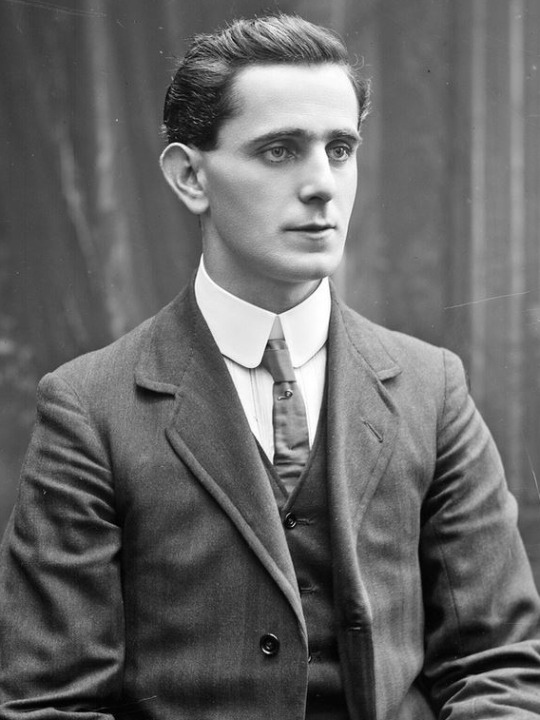
Seán Mac Diarmada
Seán Mac Diarmada (also known as Sean MacDermott) was born in Corranmore, where he was surrounded by Irish history and reminders of British oppression. By the time he moved to Dublin in 1908, he was already a member of the IRB, Sinn Fein, the Gaelic League, and the Ancient Order of Hibernians. He was also manager of the newspaper Irish Freedom which he founded with Hobson and Denis McCullough. He became close to Clarke and helped run the IRB. He was arrested briefly in 1914 for a speech against joining the British army but was released in 1915. Like Pearse, Mac Diarmada believed in the power of a bloody sacrifice and, besides Clarke, was the man most responsible for planning the rising.

Thomas MacDonagh
Thomas MacDonagh was assistant headmaster at St. Enda’s School and lecturer at University College Dublin. He was also a playwright and poet. He met Pearse and MacNeill through the Gaelic League and joined the IRB in 1915. He married Muriel Gifford whose sister, Grace, would marry Joseph Plunkett. He was also responsible in planning the funeral of Irish Fenian leader Jeremiah O’Donovan Rossa where Pearse would give one of his greatest speeches.

Joseph Plunkett
Joseph Plunkett came from a wealthy Dublin family. He contracted tuberculosis when he was young and spent considerable time in the Mediterranean and North Africa. When he returned, he joined the Gaelic League where he befriended MacDonagh. He joined the IRB in 1915 and was sent to German with Casement to negotiate for arms and military support.

Eamonn Ceannt
Eamonn Ceannt was a very religious and committed member of the Irish Volunteers. Like most Volunteers, he joined the Gaelic League when he moved to Dublin and became involved in nationalistic affairs after meeting Pearse and MacNeill. In 1907 he joined Sinn Fein and in 1915 he became a member of the IRB.

James Connolly
James Connolly was born in the Irish slums of Edinburgh and joined the British Army when he was fourteen. While serving in the army, he was involved in the Land Wars, sparking an interest in land issues and a deep hatred of the British. He deserted and became involved in the socialist movement in Scotland. He moved to Dublin when he heard that the Dublin Socialist Club was looking for a secretary and quickly transformed it into the Irish Socialist Republican Party. He, along with Arthur Griffith, protested the Boer War and he wrote a book about labor in Irish history that was very critical of Daniel O’Connell. In 1913, he co-founded the Irish Citizen Army with Jim Larkin, whose aim was to defend workers and strikers from the police. Connolly was initially disgusted with the Irish Volunteers, believing that they were too bourgeoise and didn’t have the guts to rebel against the British. It was only after meeting with Pearse and Clarke did he change his mind and support the Volunteers and the Rising.
Easter Rising Sunday
Easter Rising was a surprise for the British and for the leaders of the Irish Volunteers-Eoin MacNeill and Bulmer Hobson. Historian, Charles Townshend argues that Hobson and MacNeil were subsequently written out of Irish history because of their resistance to any violent rebellion in 1916 and it is only recently that they’ve returned to their proper place in history. While it is true that they were hesitant to lead a general uprising, it was for good reasons. The Irish Volunteers weren’t soldiers, despite all their training, and they didn’t have the weapons needed to fight a protracted rebellion. Additionally, it was doubtful that the general population would support their efforts. These concerns combined, made the Rising’s chances for success minimal.
This didn’t dissuade men like Pearse and Clarke, who planned the Rising right under MacNeill’s noses. To ensure full support of their efforts, the seven leaders of the Rising had the ‘Castle Document’ read during a meeting. This document was a plan to arrest the leaders of the Irish Volunteers should the English implement conscription. While it was a real document, it seems that the leaders may have played fast and loose with when it was going to be implemented. Either way, this was the type of repressive efforts that MacNeil believed were needed to ensure the people would support a rising of any kind. MacNeil gave orders to the men to resist and the seven leaders decided amongst themselves that the Rising would take place on 23rd April 1916. They didn’t tell anyone else though and wouldn’t until the last minute.
Then things began to unravel.
First, Roger Casement was arrested. Roger Casement had gone to Germany to recruit arms and assistance from the German government and to recruit Irishmen from the captured British soldiers. The Germans were less than supportive, and it seems Casement boarded the ship Aud to return to Ireland to either stop or postpone the rising. However, when he arrived in Ireland on either April 21st or 22nd, he was pick up by British police and placed in jail.
Then MacNeil and Hobson had their worst suspicions confirmed-Pearse and his comrades were secretly planning a rebellion without their support. There was a confrontation between MacNeil and Pearse on the 21st and MacNeil vowed to do everything possible-save warning the authorities-to stop the rebellion. However, the next day MacNeil was informed that the Germans had sent a boat full of supplies to Ireland. This seemed to convince him that things were firmly out of his control and he remained mostly mute about his feelings regarding the Rising. His opinions changed again when found out that Casement had been arrested and the arms had been picked up by the British. Feeling that this ruined what little chance the rebellion had to succeed, he spoke to Pearse once more. One can only imagine his disorientation when he found out that Hobson had been arrested by the IRB Leinster Executive out of fear that he would try to stop the rebellion. Why Pearse and his comrades never arrested MacNeil is unknown, but it speaks volumes about which man they were more threatened by.
Failing to convince Pearse that it was necessary to cancel the rebellion to avoid disaster, MacNeil wrote a counter-order, canceling the drills scheduled for Sunday. This counter-order took an already confused situation and turned it into a bewildering disaster. Units formed as ordered by Pearse and dispersed with great puzzlement and some anger and frustration. Pearse and his comrades met to discuss their next steps and decided the die had been cast. There was no other choice except to try again tomorrow, Monday, 24th, April 1916.
As can be imagined, the counter-orders have been a source of much anguish and gnashing of teeth. From the rebellion’s perceptive, it did more to ruin the Rising then the British. There is some belief that if the rebellion had occurred on Sunday as planned, with all the Irish Volunteers mobilizing, then it may have been successful. Some of this is definitely wishful thinking, as the plan for the rebellion was far from perfect to begin with. Have a larger showing of Irish Volunteers may have only meant more Irish dead at the end of the five days.
The more important question how did the decision by Pearse and his comrades to form a shadow chain of command within the Irish Volunteers affect operations? MacNeil would not have needed to issue the counter-orders if he had been in on the planning to begin with and there would have been no confusion on part of the Volunteers if commands were issued as they should have been. While it is true that Hobson and MacNeil did not want to rebel until conditions were more favorable for the Volunteers, the Rising leader’s decision to split their command in half was far more detrimental to their rebellion than anything else.
Easter Rising Monday
When the Rising began that Monday, only about half of the Irish Volunteers showed up in several key locations in Dublin and even fewer gathered in the countryside. Pearse and the others lead about 150 men down Sackville Street (now O’Connell Street) where they picked up stranglers and marched on the General Post Office (GPO). It was here they would establish their headquarters.

The General Post Office
The GPO was a formidable building and important location in Dublin, but there is some question as to whether it offered Pearse and Connolly the ability to effectively communicate with the other garrisons, especially when it was cut off from the southern half by the Castle and Trinity College.
Whatever its military significance, it became a politically powerful building. After they took the GPO, two Irish flags were hung-one was yellow, green, and orange/yellow and the other was green with a golden harp. Then Pearse read outloud the Irish Proclamation of the Republic to the newly ‘liberated’ people. This proclamation was signed by all seven leaders of the Rising-Pearse, Clarke, Ceannt, Mac Diarmada, MacDonagh, Connolly, and Plunkett-and it would later serve as their death warrant.
Whether because he read the proclamation or simply during the stress of the times, Pearse became the unofficial president and general of the Volunteers-although there were claims following the Rising that Clarke was the actual president. Additionally, the name Irish Republican Army (IRA) came out of this makeshift government. They wanted an official name for their army. It originally started as the Army of the Republic, which was changed to the IRA and became official and everlasting in the 1920s.
There was a sense of futility combined with military spirit in the GPO. While men like Pearse had always spoke of the need to wash Ireland in martyr’s blood, even practical men like Connolly seemed to believe that they were going to be slaughter. Yet, Pearse and the other leaders still struggled to develop a military command structure and government while also taking the city. As Pearse became the center of the Rising, Connolly took command of the military forces, sending out orders that his secretary, Winifred Carney, wrote on her typewriter.
While this was happening, the battalions that showed up, quickly dispersed to vital positions throughout the city.
To the east of the GPO, was the Four Courts-the Supreme Court, the Court of Appeal, the High Court, and the Dublin District Court. This was taken by the 1st battalion commanded by Edward Daly.

Edward Daly
Daly was the youngest man to serve as commandant and was Tom Clarke’s brother-in-law. Daly sent a small company under the command of Sean Heuston to take the Mendicity Institution (one of Ireland’s oldest charities). Heuston’s original orders (when GPO expected an immediate response from the British Army) were to hold the position for a few hours to give GPO time to get organized. Heuston would hold on for three days.
Southeast of the Four Courts was the South Dublin Union. This was taken by the Fourth battalion led by Eamon Ceannt, one of the seven signers of the proclamation and planners of the rising.
West of the South Dublin Union was Jacob’s biscuit factory. This was taken by the second battalion commanded by Thomas MacDonaugh, another signer of the proclamation.
West of the biscuit factory was St. Stephen’s Green, a large park. This was taken by Connolly’s Citizen Army commanded by Michael Mallin.

Michael Mallin
Mallin was Connolly’s second in command co-founder of the Socialist Party of Ireland. Constance Markievicz, a fascinating and colorful member of the Volunteers, Citizen Army, and, later, IRA, was his third in command. They tried to take Shelbourne Hotel on the north-east side of the park, but didn’t have the sufficient manpower. The British would position troops in the hotel by Monday night.
Northeast of St. Stephen’s Green was Boland’s Mill. This was taken by the Third battalion, commanded by Eamon de Valera. De Valera was a mathematics professor and had joined the Irish Volunteers out of a sense of nationalism, but only reluctantly became an IRB member. He would later distance himself from the IRB, professing a disdain for secret societies.
While the rebels certainly took a large part of the city, Dublin was surrounded by five police barracks. To the northeast there were the Royal and Marlborough barracks, to the southwest there was the Richard Barracks, to the very south was the Portobello barracks, and to the southeast was the Beggars Bush Barracks.
Additionally, the Castle, the center of British colonialism in Ireland was in the very center of Dublin, and the Volunteers didn’t take it. There was a futile attempt early Monday afternoon, but for reasons that are still unclear, it wasn’t successfully. The Volunteers also failed to take Trinity College and the telephone exchange in Crown alley, allowing the government to control communication and repair the lines that had been cut. Additionally, they failed to take Dublin’s two railways or Dublin Port and Kingstown. This would, later, enable the British to bring in army reinforcements.
There has been a lot of puzzlement over these failures, but it may have simply between due to the lack of manpower and the confusion caused by the counter-orders. There were mild gunfights throughout the day and the Volunteers waited nervously for Britain’s response. They expected it to be hard and fast, but this was furthest from the truth.
That Monday morning there were a total of 400 British soldiers on hand to respond to the rebellion. Historian Charles Townshend claims that there were 100 for each of the four barracks (Richmond, Marlborough, Royal, and Portobello). Despite knowing about the preparation for the Rising and the arms the Germans had sent, the British officials didn’t expect anything to happen that day.
The small force that engaged the rebels during Monday afternoon, were unable to displace the Volunteers. This was a short-lived victory for the rebels however, as by Monday night General Lowe had taken command along with an additional 150 troops from Belfast, and a colonel brought up the artillery from Athlone. He could expect more reinforcements from England the next day. Lowe’s plan was to establish communication along the Kingsbridge-North Wall-Trinity College line, cutting the city in half, and isolating the rebel forces from each other.
Martial law was declared, leaving Dublin’s fate in the military’s hands.
Tuesday, 25 April
By Tuesday morning, historian Charles Townshend estimates that the British military strength was up to 3000 men and Lowe estimated the rebels to be about 2000 strong, but he knew little else. He feared that the rebellion could spread to the countryside and so he requested additional reinforcements.
Despite not knowing the exact situation, Lowe’s men were able to achieve a few victories. By the end of Tuesday, they had dislodged Mallin’s men from St. Stephen’s Green and into the Royal College of Surgeons. A unit attempted to repair a section of the damaged railroad at Amiens Street but were attacked by the rebels positioned along Annesley Bridge. They fought for two hours before the British were forced to retreat.
That night, the British were able to position the four 18 pounder field guns and the guns on the HMS Helga. The British would use the artillery to great effect on Wednesday, focusing their fire on Liberty Hall, O’Connell Street, and Boland’s Mill. Connolly had once said that Britain would never fire artillery at Dublin because it was a modernized capitalistic city. One wonders what Connolly’s thoughts were during the intense bombardment.
Francis Sheehy-Skeffington
Tuesday was a day of small engagements while General Lowe assessed the situation, but that didn’t mean it wasn’t a day of tragedy. The shock of the rebellion shattered the complacency that had taken over the Irish government. With a crisis on their hands, the military responded swiftly and harshly. An example of the kind of repression the military would use during the rest of was week was the arrest of a pacifist, feminist (he had adopted his wife’s name) and prominent Irish social figure-Francis Sheehy-Skeffington.

Francis Sheehy-Skeffington
Sheehy-Skeffington was vehemently against the militarism that had taken over the Irish Volunteers and was out Tuesday trying to discourage looters. He was arrested by British Lieutenant Morris and taken to Portobello Barracks. Later that night Captain J.C. Bowen Colthurst wanted to go lead a raiding party up to Harcourt Rd. (south of St. Stephen’s Green) and he took Sheehy-Skeffington as a ‘hostage’. On the way there, he killed a young man named Coade before ransacking a house owned by the alderman Tom Kelly. He arrested two men, Thomas Dickson and Patrick McIntyre, and took them back to the barracks. He reviewed the papers he found at the alderman’s house and the papers on Sheehy-Skeffington. Wednesday morning, he took the three men out to the yard and shot them, claiming they were dangerous men and he shot them to prevent the men from escaping.
The commander of Portobello Barracks, Francis Vane, was not there during the shooting. When he found out, he demanded Colthurst’s arrest. Instead, the bodies were buried in the yard, Hanna Sheehy-Skeffington was not told about her husband’s death, and Colthurst broke into her house to find evidence that Francis Sheehy-Skeffington had helped planned the revolution. Hanna eventually found out what happened to her husband. Vane pressed to prosecute Colthurst and Vane lost his command while Colthurst kept his rank.
Colthurst was finally arrested May 9th and would later be court-martialed and convicted of insanity. He was sentenced to Broadmoor Hospital, but was released in 1918 and resettled in Canada. Vane was dishonorably discharged from the army and went on to become involved with the Boy Scouts.
Wednesday, 26 April
During Wednesday, the British tightened their grip on the city. Using their artillery to bombard positions such as O’Connell Street and Boland’s Mill, Lowe sent his new reinforcements from England into the city to further cut the rebels off from each other.
One unit was sent to attack Heuston’s position at Mendicity Institute. With only 26 Volunteers against hundreds of British soldiers, Heuston held until the British were so close, they could throw grenades into the building. His troops were the first rebels to surrender.
The Sherwood Foresters, a unit that had arrived from Britain, were sent down Grand Canal Street, near Beggar’s Bush Barracks. They were held up where Grand Canal meets Mount Street by heavy rebel fire. The Volunteers had fortified various positions along the street, meaning that the Foresters were caught in their cross-fire as they repeatedly tried to take this position. After five hours of fighting and losing 240 men wounded and killed, they defeated the rebels and took the position, but many historians have wondered why they didn’t try another path into Dublin.
Thursday 27th, and Friday 28th April
Thursday and Friday were some of the bloodiest days during the Rising. One of the greatest battles in the countryside, the Battle of Ashbourne, in which the Fingal Battalion defeated a RIC detachment took place on Friday. Within Dublin, the famous battle for the South Dublin Union occurred on Thursday and the battle for the Four Courts waged during Thursday and Friday. Friday also saw the arrival of Commander-in-chief General Sir John Maxwell, who, perhaps, did more to ensure the spiritual and political success of the Rising than anyone else.
South Dublin Union

Cathal Brugha
Eamon Ceannt and his Vice-Commandant Cathal Brugha led the men at South Dublin Union. After a furious fight on Monday, their front had been mysteriously silent. On Thursday morning, reinforcements from Kingstown port arrived and attacked. The fighting here was vicious and Brugha, who insisted on fighting in the front line, was wounded twenty-five times and had to be sent to the medical staff on Friday. Still, they held throughout the week and even thought they had destroyed the entire British force that had attacked them.
Four Courts
The most famous fight of the Rising occurred in the Four Courts. This position was vital for the rebels as it protected headquarters and was near the center of town. The Volunteers were commanded by Edward Daly. On Wednesday, he sent troops out to take Linenhall Barracks, but didn’t have the men, so they set it on fire. The fire raged for most of the night. Meanwhile the British had taken Capel street, which meant Daly was now cut off from the GPO.
The British attacked Thursday morning. Men in armed trucks rolled down Bolton street and attempted to throw a cordon on King Street. However, the rebels had heavily fortified King street, and every inch was fiercely fought over. Eventually, the British had to drill through the inside walls and travel from house to house, wounding and killing many civilians. Daly had to pull his men back to the Four Court proper on Friday night. They were exhausted, but had fought long and hard.
General John Maxwell
General John Maxwell arrive in Ireland from London on Friday. His arrival signaled that London was no longer going to be nice and understanding with their “difficult Irish citizens”. He was a traditional army man, had served in Sudan, the Boer War, and the First World War. He was to be the formal commander-in-chief for Ireland, eclipsing the civil government that had been put in place, and he, more than anyway, helped create the rebel’s legacies. His first major contribution was to refuse any negotiations short of unconditional surrender. This was to have an important effect on the now tired, starving, and rattled rebels.
The artillery barrage had kept up since Wednesday and, despite their leader’s optimism, many commanders were beginning to doubt if they could last much longer. Then the fires started. It seemed that a shell had started a fire on Sackville Street, setting it ablaze. It spread around the GPO until the men inside could feel the heat through the walls. Then an oil works on Abbey Street caught fire. Friday morning, the women were sent out of the GPO. The building was hit by shells and it caught fire around 3 pm. Things were growing desperate. Connolly, who had spent all week checking posts and men, had been wounded in his left arm and leg on Thursday and had to be carried out on a stretcher. Fire had reached the GPO roof and many of the Volunteers had been cut off from HQ, left to defend themselves in their ever-shrinking fortified positions. An Irish Volunteer, O’Rahilly, who had passed out MacNeill’s counter-order, led a bayonet charge against the British troops and was mortally wounded.
Pearse decided to surrender.
Easter Rising Executions
The order was sent to all the units in Dublin and the few who had risen in the countryside, like the Fingal, Wexford, and Galway Battalions. Most of the troops did as they were told, and they were put in temporary holding cells until the British government could figure out what to do with them.
The British government’s goal was to squash all rebellion within Ireland, thus Maxwell ordered that all Sinn Feiners be arrested. Given the number of people arrested and the severity of the crisis, it was decided that the rebels would be tried by military court. It was decided that the men would be executed, but they could not handle the disgrace of executing the women.
The first three leaders to be executed were Patrick Pearse, Tom Clarke, and Thomas MacDonaugh. They were taken out of Richmond Barracks to Kilmainham gaol and shot on May 3rd.
Edward Daly, Willie Pearse (Patricks’ younger brother), Joseph Plunkett (who was allowed to marry his fiancée the night before), and Michael O’Hanrahan were executed on the 4th.
John MacBride was executed on the 5th.
Eamon Ceannt, Sean Heuston, Con Colbert, and Michael Mallin were executed on the 8th and Thomas Kent on the 9th.
Sean MacDermott and James Connolly were executed on the 13th. Connolly, still recovering from his wounds, was tied to a chair so the soldiers could shoot him.
The government in London had become alarmed with the executions by the 4th, but allowed them to carry on until it became clear that public opinion was decidedly against them. John Redmond pleaded for clemency and the Irish public, who had been detached from the rebels at best, were beginning to praise them. It seems that the fact the Rising lasted for so long combined with the civilians who had been murdered (like Sheehy-Skeffington) and swiftness of the executions turned the public against the British forces and towards the rebels.
Given this startling development, the British government decided to intern the remaining rebbels at various prisons and internment camps in England and Wales such as Frongoch, the “University of Revolution’.
The last Irish Volunteer to be executed was Roger Casement. He was tried for treason and was hanged on August 3rd.
Legacy
“That the authorities allowed a body of lawless and riotous men to be drilled and armed and to provide themselves with an arsenal of weapons and explosives was one of the most amazing things that could happen in any civilized country outside of Mexico.”-William Martin Murphy, statement to Royal Commission 1916
It is true that the Irish Volunteers lasted longer than anyone expected (maybe even longer then their own leaders expected), yet that alone cannot count as a victory. Despite their best efforts, the plans for the Rising were muddled and the secret nature of their work only hurt their cause. It tore their movement in two, creating a political vacuum that allowed the IRB to take control, but also created a legacy of distrust. There would always be those members who suspected the IRB and this suspicion that would continue into the Irish War of Independence and contribute to the Irish Civil War and the aftermath of the 1924 Army Mutiny.
Once the Rising started, the battalions quickly became isolated commands of their own, their connection to the GPO and the leadership fragile. There were several brave stands during the Rising, such as Heuston’s stand at the Medicity Institute, Ceannt’s stand at the Four Courts, and the Battle of Ashbourne in the countryside and no one can deny the courage or dedication of the men who rebelled.
However, it is also hard to deny the tragedy of the entire affair. It has been estimated that a total of 485 people had been killed and 2,600 had been wounded during the rebellion. Ireland lost many important men and women such as Francis Sheehy-keffington, Michael Joseph O’Rahilly (the O’Rahilly) and promising leaders such as Sean Heuston and Edward Daly. Dublin city had been bombarded, burnt, and filled with lead and the Rising pushed the English to establish a military governor, John Maxwell.
So, it was a disaster?
It may have been nothing more than another failed uprising had it not been for the brutal murder of men like Sheehy-Skeffington and the executions. One cannot completely fault John Maxwell. Governments and military men often fall into the trap of believing that a rebellion cannot survive without its leadership. The British never expected the survivors to pick up the torch light by the signers of the Irish Proclamation.
De Valera was scheduled to be executed, but was spared because of the change in public opinion. Michael Collins had originally been marked for harsher punishment (such as execution) but was saved because he thought he heard someone call his name and moved to the group marked for lighter punishment in an attempt to identify the voice. Once he joined that group, he just stayed there. These two men would be instrumental in shaping the Irish War of Independence and modern Ireland.
Additionally, men and women like Cathal Brugha, Richard Mulcahy, W. T. Cosgrave, Arthur Griffith, Constance Markievicz, Harry Boland, and many more all participated in Easter Rising, many were interned in prisons like Frongloch internment camp, and would later become vital to the IRA in one capacity or another.
Easter Rising provided these future leaders of Ireland a glimpse into what worked and what didn’t. Michael Collins, himself, was disgusted with the loss of life and Richard Mulcahy, the IRA’s future chief of staff, experienced guerrilla warfare for the first time during the Battle of Ashbourne. De Valera’s experience in Dartmoor prison gave him the reputation and confidence he needed to become President of the Dail. It also created a moment of everlasting brotherhood that created the esprit de corps needed to survive the Irish War of Independence War and the very same brotherhood that would tear Ireland apart during the civil war.
The legacy of Easter Rising will always be tangled with the legacy of the Irish War of Independence and the Civil War. Was it any different from other Irish rebellions? In some ways, yes, in some ways, no. Was Pearse right? Did Ireland need a bloody sacrifice to be free? It is hard to agree with Pearse when Ireland had made many such bloody sacrifices during its long history and would make many more from 1919 up to the signing of the Good Friday Agreement. Can the full impact of Easter Rising be understood outside the context of the First World War and the technological advance that had been made in everyday life and in military affairs? Probably not.
The hardest part about assessing the Rising’s legacy is because of its larger than life narrative. The Rising was immortalized shortly after it was over by poets such as Yeats and, since many members of the IRA fought in the Rising, they added to this immortalization as they won independence and struggled to create a state. There was some reassessment in the 60s and 70s, but, as the 100 year anniversary revealed, Ireland still struggles to properly categorize and understand the Rising.
Despite the changing narrative surrounding the Rising, there is one thing that cannot be denied. The sacrifice of the men and women who fought will continue to challenge and inspire us as we worked to undo the damage caused by colonialism and small nations continue to fight to be free.
If you like this post, join my Patreon
References:
Foster, R. F. Modern Ireland 1600–1972
Townshend, Charles. Easter Rising: the Irish Rebellion
Townshend, Charles. the Republic
Foster R.F. Vivid Faces
Coogan, Tim Pat. Michael Collins: the Man Who Made Ireland
Coogan, Tim Pat. Eamon de Valera: the Man Who was Ireland
Fanning, Ronan. Eamon de Valera: a Will to Power
Valiulis, Maryann Gialanella. Portrait of a Revolutionary: General Richard Mulcahy and the Irish Free State
Images-Wikicommons
Bulmer Hobson-https:// commons.wikimedia.org/wiki/File:Bulmer_Hobson.jpg
Eoin MacNeill: https://commons.wikimedia.org/wiki/File:Eoin_MacNeill.jpg
GPO Easter Rising 1916-By RossGannon1995 [CC BY-SA 4.0 (https://creativecommons.org/licenses/by-sa/4.0)%5D, from Wikimedia Commons
Edward Daly-Public Domain
Michael Mallin-By National Library of Ireland on The Commons [No restrictions, Public domain or Public domain], via Wikimedia Commons
Francis Shehy Skeffington: By photographer not identified [Public domain], via Wikimedia Commons
Cathal Brugha: See page for author [Public domain or Public domain], via Wikimedia Commons
The O’Rahilly: By National Library of Ireland on The Commons (The O’Rahilly) [No restrictions, Public domain or Public domain], via Wikimedia Commons
#easter rising#irish history#patrick pearse#tom clarke#sean mac diarmada#thomas macdonagh#eamonn ceannt#cathal brugha#eamon devalera#daniel o'connell#charles parnell#world war I#john redmond
6 notes
·
View notes
Text
#OTD in 1883 – Execution of Joe Brady for the murder of Lord Cavendish in Phoenix Park.
Brady was one of the Invincibles – a Fenian splinter group – that murdered the Chief Secretary of Ireland on his first day in the country. Four others were executed for the murders. Brady by all accounts was a mountain of a man. The Times wrote after his execution. “He was brought up as a stonemason of herculean strength, his occupation developing the muscular power of his arms, which told with…

View On WordPress
#Charles Stewart Parnell#Dan Curley#Dublin#Fenians#Glasnevin Cemetery#James “Skin the Goat” Fitzharris#James Joyce#Joe Brady#Lord Cavendish#Michael Fagan#Phoenix Park Murders#T.H. Burke#The Invincibles#Thomas Caffrey#Tim Kelly#Ulysses
6 notes
·
View notes
Photo
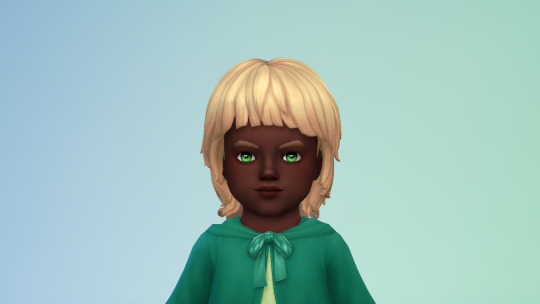
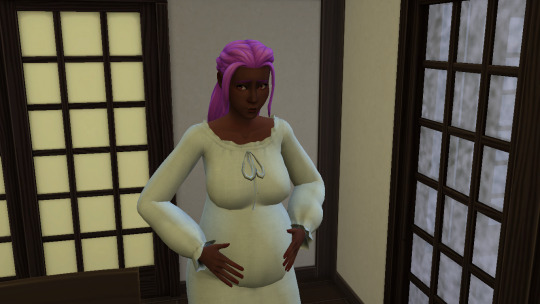



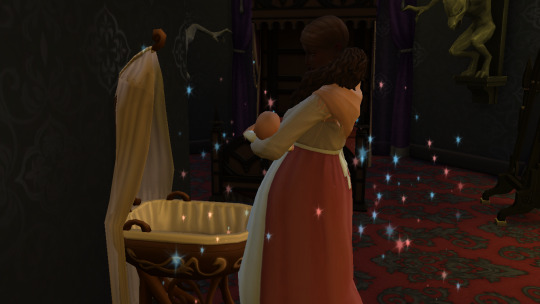
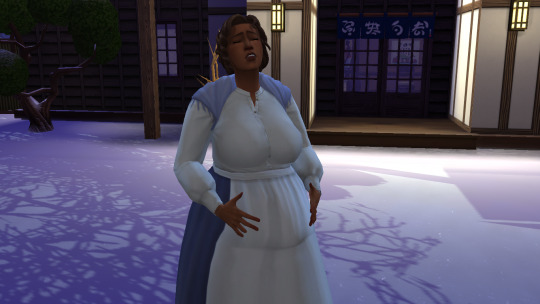
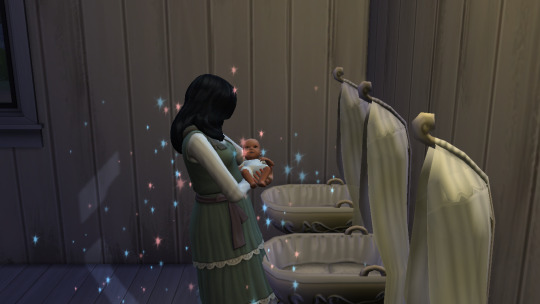

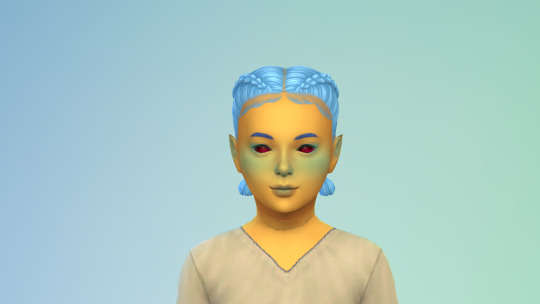
1500-1599 Recap Part 73:
Janet Silversweater became a toddler.
Philippa gave birth and her birth roll was literally one away from death so I had to make it dramatic, obviously lol.
Thomas and Alice Kibo became children in time to become older siblings to Arthur.
Thomasin went into labor around the same time as Patricia.
Patricia had her son Melrose.
Thomasin and Philippa unfortunately lost one of their twins in the birth. At this point I realized that every one of Adrian’s daughters had lost their first born child up until this point.
Joyce became a child.
#Thomasin Carlisle#Philippa Carlisle#Patricia Silversweater#Janet Kibo#Janet Silversweater#Thomas Kibo#Alice Kibo#Joyce Carlisle#Parnell Jernigan#Elric Carlisle#Arthur Kibo#Melrose Silversweater#The Carlisle Chronicles#Decades Legacy Challenge#1500-1599 Recap#ts4
3 notes
·
View notes
Text
Riot Press’s “Zorro and the Phantasm Cult of Hollywood Hills, 1955" Makes Its Mark
Riot Press’s “Zorro and the Phantasm Cult of Hollywood Hills, 1955" Makes Its Mark | #comics #Zorro #IndieComics #MonochromeMay #art
Over the weekend, Riot Press launched a crowdfunding campaign for Zorro and the Phantasm Cult of Hollywood Hills, 1955, a 24-page, black and white comic book. The project is already fully funded, having raised more than $3 thousand at the time of this writing. Written and illustrated by Patrick Thomas Parnell,* Zorro and the Phantasm Cult is a reimagining of the classic folk hero that puts the…
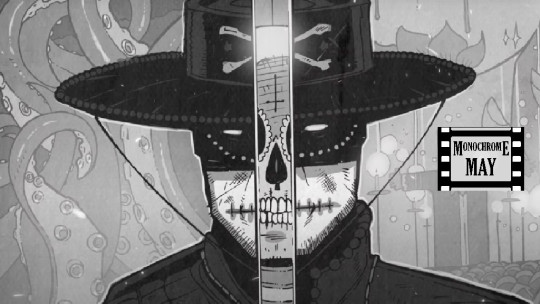
View On WordPress
#Featured#Johnny Phantasm#Monochrome May#Patrick Thomas Parnell#Riot Press#Zorro and the Phantasm Cult of Hollywood Hills 1955
1 note
·
View note
Text

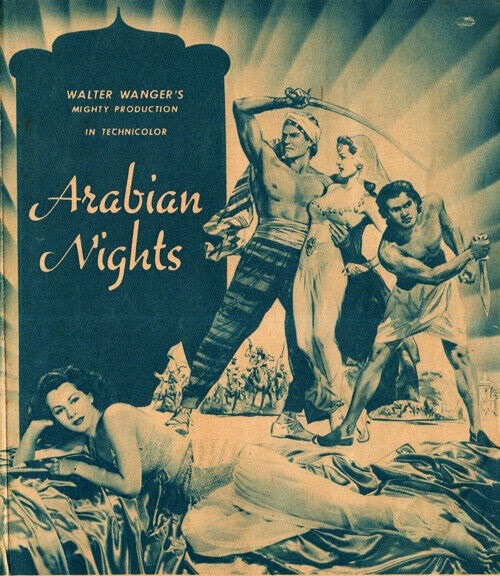
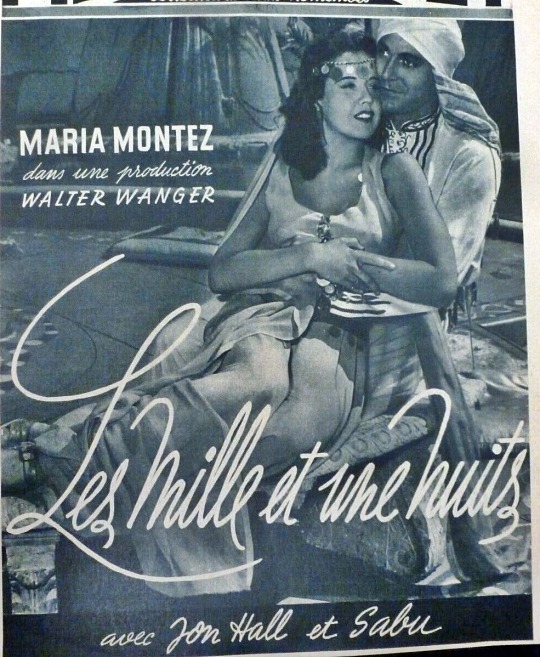


Arabian Nights
Arabian Nights is a 1942 adventure film directed by John Rawlins and starring Jon Hall, Maria Montez, Sabu and Leif Erikson. The film is derived from The Book of One Thousand and One Nights but owes more to the imagination of Universal Pictures than the original Arabian stories. Unlike other films in the genre (The Thief of Bagdad), it features no monsters or supernatural elements.
This is the first feature film that Universal made using the three-strip Technicolor film process, although producer Walter Wanger had worked on two earlier Technicolor films for other studios: The Trail of the Lonesome Pine (1936) at Paramount and the 1937 Walter Wanger's Vogues of 1938 for United Artists.
Plot (it may contain spoilers)
In ancient Persia, the young women of a royal harem read the story of Sherazade, unfolding the film's story. Sherazade, a dancer in a wandering circus, captures the attention of Kamar, the brother of the caliph, Haroun al-Rashid. Kamar's infatuation influences his attempts to seize the throne from Haroun and make Sherazade his queen. His revolt fails, and he is sentenced to slow death by exposure, but Kamar's men storm the palace and free their leader. Wounded and forced to flee, Haroun chances upon Sherazade's circus and is spotted by the young acrobat Ali Ben Ali. Aware of Haroun's identity, Ali hides him in the circus. Later, upon awakening from his injuries, Haroun beholds Sherazade and falls in love with her.
Meanwhile, Kamar assumes the throne, but Sherazade is not to be found. He orders the captain of his guard to find her, but a scheming grand vizier, Nadan, approaches the captain with the order to make Sherazade 'disappear.' After finding them, the captain sells the troupe into slavery. When the captain is found out, Nadan murders him in order to conceal his treachery. Haroun, Sherazade, and the acrobats escape the slave pens, but are found by Kamar's army and taken to a tent city in the desert. Kamar reunites with Sherazade and proposes, but she has fallen in love with Haroun instead. Nadan, recognizing the caliph, uses this knowledge to blackmail Sherazade into helping him remove Kamar from the throne, in return for safe conduct for Haroun out of the caliphate. In secret, however, he plans to have Haroun killed once he has crossed the border.
Upon learning of this insidious scheme, Ali and his fellow performers rescue Haroun, who then decides to free Sherazade with the help of the acrobats. But Haroun and the others are quickly captured, and Sherazade finally learns his true identity. Kamar engages Haroun in a swordfight, while the acrobats set fire to the tents; and the arrival of the caliph's loyal troops, summoned by Ali, triggers a massive battle. In the end, as Kamar prepares to deliver the deathstroke to Haroun, Nadan assassinates Kamar. But as he prepares to do in Haroun, Ahmad and Ali interfere, forcing him to flee. Nadan is stopped by a thrown spear and dies inside a burning tent, leaving Haroun, Sherazade, and their loyal friends to celebrate victory.
Cast
Jon Hall – Haroun-Al-Raschid
Maria Montez – Sherazade
Sabu – Ali Ben Ali
Leif Erikson – Kamar
Billy Gilbert – Ahmad
Edgar Barrier – Nadan
Richard Lane – Corporal
Turhan Bey – Captain of the Guard
John Qualen – Aladdin
Shemp Howard – Sinbad
William 'Wee Willie' Davis – Valda
Thomas Gomez – Hakim
Jeni Le Gon – Dresser / Dancer's Maid
Robert Greig – Eunuch
Charles Coleman – Eunuch
Emory Parnell – Harem Sentry
Harry Cording – Blacksmith
Robin Raymond – Slave Girl
Carmen D'Antonio – Harem Girl
The film was released on 25th December 1942.
Photos from ebay and text from wikipedia.
#Maria Montez#María Montez#1942#1942 Maria#Arabian Nights#1942 Arabian Nights#John Rawlings#John Hall#Sabu#Leif Erikson#Turham Bey#actress#La Reina del Tecnicolor#The Queen of technicolor#Montez Family#Gracia Family#Universal Pictures
16 notes
·
View notes
Text
Let's go for Political Awareness in 2025
Listen, I've never considered myself interested in Politics but this year, and for my future, I'm making it a goal to be more involved. Nothing gets better if we don't do anything about it. The recent election and inauguration has a lot of people (myself included) feeling rather nauseous and generally full of dread.
So, I've compiled lists of Celebrities, Companies, Music Artists to Block on your socials and music streaming services. And a list of Banned/Challenged books to read or try to gain copies of (if you're in a place where you're able to.) I'll also be including a link to a google doc at the end of this that's open access. Feel Free to Add to the list, but here's what I've found.
Celebrities/Public Figures:
Mark Zuckerberg
Elon Musk
Shou
Megyn Kelly
Joe Rogan
Caitlyn Jenner
Jake/Logan Paul
Buzz Aldrin
Hulk Hogan
James Woods
Kevin Sorbo
Roseanne Barr
Russell Brand
Dana White
Rob Schneider
Amber Rose
Savannah Chrisley
Randy Quaid
Dennis Quaid
Danica Patrick
Robert F. Kennedy Jr.
Zachary Levi
Jim Caviezel
John Daly
Tucker Carlson
Harrison Butker
Brittany Mahomes
Joe Exotic
Victoria Jackson
Brett Favre
Paula Deen
Mel Gibson
John Schneider
Richelle Ryan
Dr. Phil
Tony Hinchcliffe
Bryce Hall
Sylvester Stallone
Jeff Bezos
Music Artists (Socials + Spotify!!)
Carrie Underwood
Snoop Dogg
Lee Greenwood
Christopher Macchio
Kid Rock
The Village People
Billy Ray Cyrus
Nelly
Jason Aldean
Rascal Flatts
Parker McCollum
Gavin DeGraw
Mormon Tabernacle Choir
Jackie Evancho
Sexyy Red
Lil Wayne
Lil Pump
50 Cent
Chris Janson
Kodak Black
Kanye West
Taryn Manning
Kelsey Grammer
Companies:
Top Contributors, federal election data for Donald Trump, 2024 cycle - OpenSecrets
Meta
Facebook
Instagram
SpaceX
Amazon
Coca Cola
OpenAI
Banned/Challenged Books:
Office for Intellectual Freedom | ALA
Why Are Books Banned? - EveryLibrary Action
Top 100 Most Frequently Challenged Books: 2010-2019
https://www.aseatatthetablebooks.org/lists/LSqDQChLIR3g/4
Book banning is a form of censorship. Reading and access to all library resources is your First Amendment right.
Handmaid’s Tale - Margaret Atwood
1984 - George Orwell
Animal Farm - George Orwell
Brave New World - Aldous Huxley
Fahrenheit 451 - Ray Bradbury
The Curious Incident of the Dog in the Night-Time - Mark Haddon
The Giver - Lois Lowry
I Know Why the Caged Bird Sings - Maya Angelou
Slaughterhouse-Five - Kurt Vonnegut
A Clockwork Orange - Anthony Burgess
The Color Purple - Alice Walker
Hunger Games - Suzanne Collins
To Kill a Mockingbird - Harper Lee
Of Mice and Men - John Steinbeck
The Adventures of Huckleberry Finn - Mark Twain
The Catcher in the Rye - J. D. Salinger
Anne Frank: Diary of a Young Girl - Anne Frank
Lolita - Vladimir Nabokov
Lord of the Flies - William Golding
The Grapes of Wrath - John Steinbeck
A Farewell to Arms - Ernest Hemingway
A Lesson Before Dying - Ernest J Gaines
For Whom the Bell Tolls - Ernest Hemingway
The Great Gatsby - F. Scott Fitzgerald
One Flew Over the Cuckoo's Nest - Ken Kesey
Critical Race Theory: The Key Writings That Formed the Movement - Kimberle Crenshaw, Neil Gotanda, Garry Peller, Kendall Thomas
Fight Club - Chuck Palahniuk
Catch-22 - Joseph Heller
Call of the Wild - Jack London
The Red Badge of Courage - Stephen Crane
The Perks of Being a Wallflower - Stephen Chbosky
And Tango Makes Three - Justin Richardson, Peter Parnell, Henry Cole
The Children and the Wolves - Adam Rapp
Sold - Patricia McCormick
Google Doc Link:
2 notes
·
View notes
Text
7 Banned Books to Read this Banned Book Week

With book bans sweeping the United States, the Duck Prints Press rec list contributors wanted to take a moment to shout out our favorite books that get banned most frequently. Being us, they are, unsurprisingly, mostly queer.
Learn more about Banned Books Week.
-
Melissa by Alex Gino
When people look at George, they think they see a boy. But she knows she’s not a boy. She knows she’s a girl. George thinks she’ll have to keep this a secret forever. Then her teacher announces that their class play is going to be Charlotte’s Web. George really, really, REALLY wants to play Charlotte. But the teacher says she can’t even try out for the part . . . because she’s a boy. With the help of her best friend, Kelly, George comes up with a plan. Not just so she can be Charlotte—but so everyone can know who she is, once and for all.
-
A Day in the Life of Marlon Bundo, written by Jill Twiss and illustrated by E. G. Keller
Meet Marlon Bundo, a lonely bunny who lives with his Grampa, Mike Pence – the Vice President of the United States. But on this Very Special Day, Marlon’s life is about to change forever…
With its message of tolerance and advocacy, this charming children’s book explores issues of same sex marriage and democracy. Sweet, funny, and beautifully illustrated, this book is dedicated to every bunny who has ever felt different.
-
I Never Promised You a Rose Garden by Joanne Greenberg
I Never Promised You a Rose Garden is the story of a sixteen-year-old who retreats from reality into the bondage of a lushly imagined but threatening kingdom, and her slow and painful journey back to sanity.
Chronicles the three-year battle of a mentally ill, but perceptive, teenage girl against a world of her own creation, emphasizing her relationship with the doctor who gave her the ammunition of self-understanding with which to help herself.
-
The Hate U Give by Angie Thomas
Sixteen-year-old Starr Carter moves between two worlds: the poor neighborhood where she lives and the fancy suburban prep school she attends. The uneasy balance between these worlds is shattered when Starr witnesses the fatal shooting of her childhood best friend Khalil at the hands of a police officer. Khalil was unarmed.
Soon afterward, his death is a national headline. Some are calling him a thug, maybe even a drug dealer and a gangbanger. Protesters are taking to the streets in Khalil’s name. Some cops and the local drug lord try to intimidate Starr and her family. What everyone wants to know is: what really went down that night? And the only person alive who can answer that is Starr.
But what Starr does—or does not—say could upend her community. It could also endanger her life.
-
And Tango Makes Three, written by Justin Richardson and Peter Parnell, illustrated by Henry Cole
At the penguin house at the Central Park Zoo, two penguins named Roy and Silo were a little bit different from the others. But their desire for a family was the same. And with the help of a kindly zookeeper, Roy and Silo get the chance to welcome a baby penguin of their very own.
-
Forever… by Judy Blume
Katherine and Michael meet at a New Year’s Eve party. They’re attracted to each other, they grow to love each other. And once they’ve decided their love is forever, they make love.
It’s the beginning of an intense and exclusive relationship, with a future all planned. Until Katherine’s parents insist that she and Michael put their love to the test with a summer apart…
-
It’s Perfectly Normal: Changing Bodies, Growing Up, Sex, and Sexual Health, written by Robie H. Harris and illustrated by Michael Emberley
When young people have questions about sex, real answers can be hard to find. Providing accurate, unbiased answers to nearly every imaginable question, from conception and puberty to birth control and AIDS, It’s Perfectly Normal offers young people the information they need—now more than ever—to make responsible decisions and to stay healthy.
-
What are YOU reading this Banned Book Week?
15 notes
·
View notes
Text
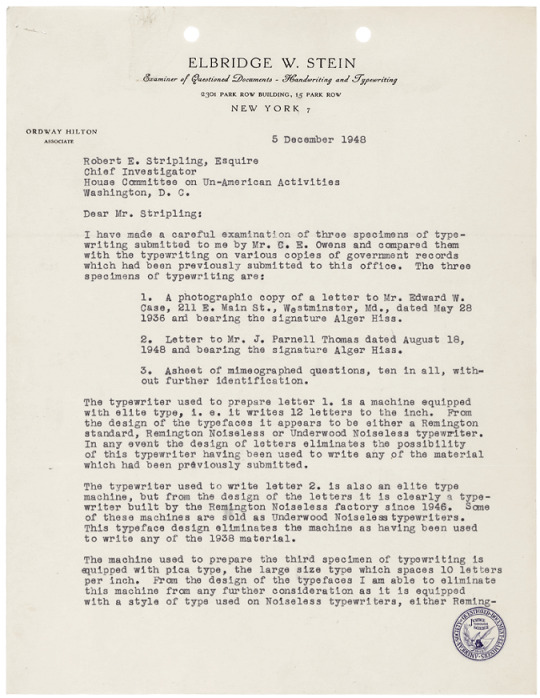
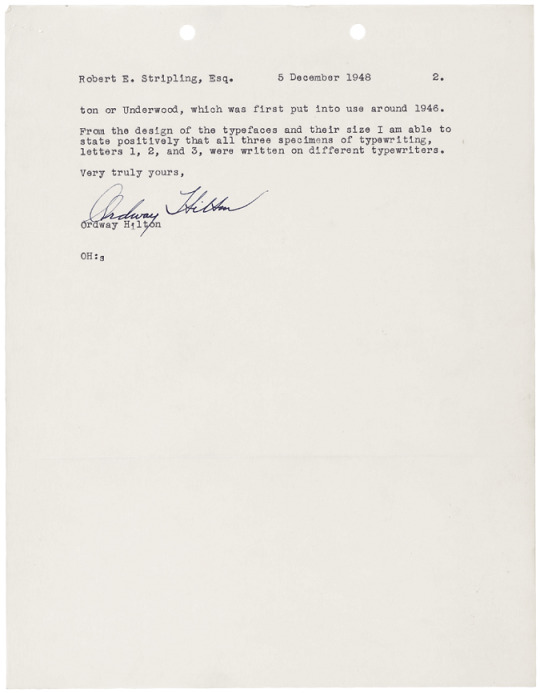
Letter from Ordway Hilton to Robert Stripling Regarding Alger Hiss
Record Group 233: Records of the U.S. House of RepresentativesSeries: Investigative Name Files
[letterhead] Elbridge W. Stein Examiner of Questioned Documents - Handwriting and Typewriting 2301 Park Row Building, 15 Park Row New York 7 5 December 1948 Robert E. Strping, Esquire Chief Investigator House Committee on Un-American Activities Washington, D.C. Dear Mr. Stripling: I have made a careful examination of three specimens of typewriting submitted to me by Mr. C.E. Owens and compared them with the typewriting on various copies of government records which had been previously submitted to this office. The three specimens of typewriting are: 1. A photographic copy of a letter to Mr. Edward W. Case, 211 E. Main St., Westminster, Md., dated May 28 1936 and bearing the signature Alger Hiss. 2. Letter to Mr. J. Parnell Thomas dated August 18, 1948 and bearing the signature Alger Hiss. 3. A sheet of mimeographed questions, ten in all, without further identification. The typewriter used to prepare letter 1. is a machine equipped with elite type, i.e. it writes 12 letters to the inch. From the design of the typefaces it appears to be either a Remington standard, Remington Noiseless or Underwood Noiseless typewriter. In any event the design of letters eliminates the possibility of this typewriter having been used to write any of the material which had been previously submitted. The typewriter used to write letter 2. is also an elite type machine, but from the design of the letters it is clearly a typewriter built by the Remington Noiseless factory since 1946. Some of these machine are sold as Underwood Noiseless typewriters. This typeface design eliminates the machine as having been used to write any of the 1938 material. The machine used to prepared the third specimen of typewriting is equipped with pica type, the large size type which spaces 10 letters per inch. From the design of the typefaces I am able to eliminate this machine from any further consideration as it is equipped with a style of type used on Noiseless typewriters, either Remington Robert E. Stripling, Esq. 5 December 1948 2. Remington or Underwood, which was first put into use around 1946. From the design of the typefaces and their size I am able to state positively that all three specimens of typewriting, letters 1, 2, and 3, were written on different typewriters. Very truly yours, [handwritten signature] Ordway Hilton [typed signature] Ordway Hilton OH:3
#archivesgov#December 30#1948#1940s#huac#house committee on unamerican activities#alger hiss#red scare#mccarthyism
11 notes
·
View notes
Photo

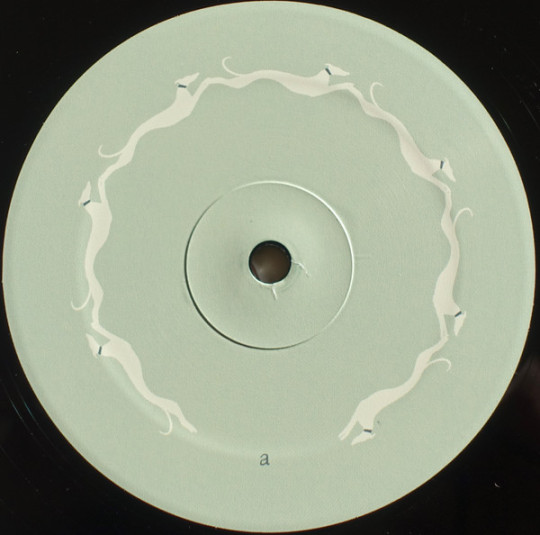


Vashti Bunyan - Lookaftering (Gatefold)
[id for bottom image]
THANK YOU
Max Richter for patience and wisdom and shining music
Yulia, Lucie and Noah for Max’s hours and hours
FatCat’s Dave Howell, Alex Knight, Dave Cawley and Marcus Thorne for their faith
and Gary Held of DiCristina for his
Dave Thomas for all the time and hand-painted writing
Paul Lambden for being solid ground while I was all at sea
Glen Johnson who invited me back
Simon Raymonde who started the new
Devendra Banhart for sooooooo much
Robert Kirby for trumpet, French horn and remembering
Marcelo Oliviera who told me I could play guitar for myself
Adem for playing and carrying the harmonium and everything so far
Joanna Newsom who had little time and yet gave us so many notes
Otto Hauser and Kevin Barker and Andy Cabic for coming by to play
Adam Pierce for the hammer dulcimer
Dave Gray, David Paterson, Philip Bagernal and Anna Tjan for engineering
Mandy Parnell for welcome and mastering
Elise McKay who listened to the words
Jenny Wright for imploring the air to make Jenny Richardson better.. it did
Corrina Seddon for good friendship
My children - Leif who gave me his beloved old Martin guitar, Whyn for letting me have her luminous paintings here, and Benjamin for always going his sweet way
Rowan, Rachel and Patrick
sister Sue Heath, Inda Bunyan and missed brother John
Al Campbell.. thankyou always
33 notes
·
View notes
Text
“ Invece di seguire il programma di austerità del suo predecessore Hoover, il presidente del New Deal, come ha notato Barbara Spinelli su «la Repubblica», «aumentò ancor più le spese federali. Investì enormemente sulla cultura, la scuola, la lotta alla povertà». Purtroppo, aggiunge la Spinelli, «non c’è leader in Europa che possegga, oggi, quella volontà di guardare nelle pieghe del proprio continente e correggersi. Non sapere che la storia è tragica, oggi, è privare di catarsi e l’Italia, e l’Europa». Già: addirittura una «catarsi». Ma è proprio quello che ci vorrebbe. Roosevelt, infatti, non mise solo i disoccupati a scavare buche e a riempirle, come tanto spesso si dice. Tre dei più importanti progetti della Works Progress Administration, i più singolari, innovativi e duraturi, furono quelli compresi nel cosiddetto Progetto Federale numero 1, altrimenti noto come Federal One, che sponsorizzò per la prima volta piani di lavoro per insegnanti, scrittori, artisti, musicisti e attori disoccupati. Il Federal Writers’ Project, il Federal Theatre Project e il Federal Art Project misero al lavoro per qualche anno più di ventimila knowledge workers (come li chiameremmo oggi), tra i quali c’erano Richard Wright, Ralph Ellison, Nelson Algren, Frank Yerby, Saul Bellow, John A. Lomax, Arthur Miller, Orson Welles, Sinclair Lewis, Clifford Odets, Lillian Hellman, Lee Strasberg (il fondatore del mitico Actors Studio) ed Elia Kazan. Non si trattò di elemosina: checché. Oltre a produrre opere d’arte (migliaia di manifesti, disegni, murales, sculture, pitture, incisioni...), gli artisti plastici e figurativi vennero impiegati nella formazione artistica e nella catalogazione dei beni culturali, e crearono e resero vivi anche un centinaio di community art centres e di gallerie in luoghi e regioni in cui l’arte era completamente sconosciuta. In tre anni, nella sola New York, più di dodici milioni (12.000.000!) di persone assistettero agli spettacoli teatrali incentivati dal Federal Theatre Project. Quanto al Writers’ Project, che costò ventisette milioni di dollari in quattro anni, produsse centinaia di libri e opuscoli, registrò storie di vita di migliaia di persone che non avevano voce e le classificò in raccolte etnografiche regionali, ma soprattutto, con le American Guide Series, contribuì a ridare forma all’identità nazionale degli Stati Uniti, che la Grande Depressione aveva profondamente minato, fondandola su ideali più inclusivi, democratici ed egualitari. E scusate se è poco. Tuttavia anche lì, e anche allora, non mancavano i sostenitori dell’idea che la cultura è un lusso e, soprattutto, un lusso di sinistra. Dal maggio del 1938, sotto la guida di due «illuminati statisti» come Martin Dies e J. Parnell Thomas, la Commissione della Camera contro le attività antiamericane non smise di accusare i tre progetti di essere al soldo di Mosca e non si arrese fino a quando non furono fermati. Poi, venne la guerra e molti sogni si infransero. Ma intanto, con quel solido lavoro culturale alle spalle, le fondamenta di una nuova consapevolezza di sé e di una nuova idea di futuro erano comunque gettate. E da lì, dall’idea di fondo della necessità dell’intervento statale per vivificare la cultura e modificare così la specializzazione produttiva di un Paese, partirà, già durante la guerra, un altro liberale illuminato, Vannevar Bush, consigliere di Roosevelt, per elaborare il famoso rapporto Science: the Endless Frontier, che rappresenta un po’ il manifesto della politica culturale e scientifica – e a ben vedere anche economica – che avrebbero seguito gli Stati Uniti nei successivi decenni fino a Barack Obama. “
Bruno Arpaia e Pietro Greco, La cultura si mangia, Guanda (collana Le Fenici Rosse), 2013¹ [Libro elettronico]
#Bruno Arpaia#Pietro Greco#La cultura si mangia#saggistica#intellettuali italiani#economia#Giulio Tremonti#la Repubblica#Franklin Delano Roosevelt#New Deal#Barbara Spinelli#FDR#knowledge workers#Italia#Europa#disoccupazione#XX sec#Works Progress Administration#Storia del '900#Federal One#Federal Writers’ Project#Federal Theatre Project#America#Commissione contro le attività antiamericane#Saul Bellow#Federal Art Project#Arthur Miller#Orson Welles#Elia Kazan#Sinclair Lewis
22 notes
·
View notes
Photo

The Broomstick Killer
Kenneth Allen McDuff was born at 201 Linden Street in the central Texas town of Rosebud, the fifth of six children born to John Allen "JA" and Addie McDuff. At Rosebud High School, McDuff earned the reputation of being a bully. He was careful to pick on weaker individuals after the large but not strong McDuff lost a fight he had picked with an athletic and popular boy named Tommy Sammons. As a result, he quit school and worked for his father's business doing manual labor. McDuff would often brag in later interviews that old ladies loved the way he mowed their lawns, making others jealous. McDuff was convicted of a series of burglaries and put in prison.
On August 6, 1966, McDuff and Green, whom he had met around a month earlier through a mutual acquaintance, spent the day pouring concrete for McDuff's father. They then drove around, as McDuff said he was looking for a girl. At 10 pm, Robert Brand (aged 17), his girlfriend Edna Louise Sullivan (aged 16), and Brand's 15-year-old cousin Mark Dunman were standing beside their parked car on a baseball field in Everman, Texas. While cruising around, McDuff noticed Sullivan and parked around 150 yards away from the soon-to-be victims. He threatened the trio with his .38 Colt revolver and ordered them to get into the trunk of their car. With Green following in McDuff's car, McDuff drove the victims' Ford along a highway and then into a field, where he ordered Sullivan out of the trunk of the Ford and instructed Green to put her into the trunk of his Dodge Coronet. At this point, according to Green's statement, McDuff said he would have to "knock 'em off"; he proceeded to fire six shots into the trunk of the Ford in spite of Dunman and Brand's pleas not to. McDuff then instructed Green to wipe the fingerprints off the Ford.
After driving to another location, McDuff and Green, the latter allegedly under duress, raped Sullivan. After she was raped repeatedly, McDuff asked Green for something with which to strangle her. Green gave him his belt. However, in the end, McDuff opted to use a 3-foot-long (0.91 m) piece of broomstick from his car. He choked Sullivan, and then Green and he dumped her body in some bushes. They purchased Coca-Cola from a Hillsboro gas station before driving to Green's house to spend the night. The following day, McDuff buried his revolver beside Green's garage, and their mutual acquaintance Richard Boyd allowed McDuff to wash his car at his house. The next day, Green confessed to Boyd's parents, who told Green's mother, who convinced him to turn himself in. McDuff was arrested by Falls County Sheriff Brady Pamplin (who served with Texas Rangers before serving in World War II with United States Army Air Corps) and Deputy U.S. Marshal Thomas Parnell “T.P.” McNamara, Sr.
McDuff received a death sentence in Texas' electric chair; Green received a 25-year sentence and was released in 1979. McDuff's death sentence was commuted to a life sentence, and he hired a lawyer, who amassed a dossier of various evidence that claimed to show that Green was the real killer. Some members of the parole board were impressed by the dossier. During a one-on-one interview with a board member, McDuff offered him a bribe to secure a favorable decision on the parole application. He was given a two-year sentence for trying to bribe the official. It proved meaningless, as board members thought McDuff could still "contribute to society" and decided to grant him a parole. He was released in 1989.
McDuff was one of 20 former death-row inmates and 127 murderers to be paroled. After being released, he got a job at a gas station making $4 an hour while taking a class at Texas State Technical College in Waco. Within three days of his release, he is widely believed to have begun killing again. The body of 29-year-old Sarafia Parker was discovered on October 14, 1989, in Temple, a town 48 miles south of Waco along the I-35 corridor. McDuff was not charged with this crime. However, he was soon returned to prison on a parole violation for making death threats to an African American youth in Rosebud.
Addie McDuff paid $1,500, plus an additional $700 for expenses, to two Huntsville attorneys in return for their "evaluating" her son's prospect of release. On December 18, 1990, McDuff was again released from prison. On the night of October 10, 1991, he picked up a prostitute named Brenda Thompson in Waco. He tied her up, but then stopped his truck about 50 ft from a police checkpoint. When a policeman walked toward McDuff's vehicle, Thompson repeatedly kicked at the windshield of McDuff's truck, cracking it several times.
McDuff accelerated very quickly and drove at the officers. According to a statement filed by the officers later, three of them had to jump to avoid being hit. The policemen gave chase, but McDuff eluded them by turning off his lights and traveling the wrong way down one-way streets. Ultimately, he parked his truck in a wooded area near U.S. Route 84 and tortured Thompson to death. Her body was not discovered until 1998.
Five days later, on October 15, 1991, McDuff and a 17-year-old prostitute named Regenia DeAnne Moore were witnessed having an argument at a Waco motel. Shortly thereafter, the pair drove in McDuff's pickup truck to a remote area beside Texas State Highway 6, near Waco. McDuff tied her arms and legs with stockings before killing her. She had been missing from home for 7 years by the time her body was discovered on September 29, 1998. McDuff is also believed to have murdered Cynthia Renee Gonzalez, 23, who was found dead in a creek bed near County Road 313 in heavily wood terrain 1 mile west of I-35 on September 21, 1991, some six days after she was reported missing in Arlington.[4]
McDuff and an accomplice, Alva Hank Worley, murdered Colleen Reed, a Louisiana native, on December 29, 1991. McDuff and Worley drove to an Austin car wash and kidnapped Reed in plain sight of eyewitnesses before driving away. Worley admitted in an April 1992 interview with the Bell County Sheriff's Department that he had raped Reed and tortured her with cigarettes, but he stated that he did not participate in her murder.
McDuff's next victim was Valencia Joshua, a prostitute who was last seen alive knocking on McDuff's door. He strangled Joshua on February 24, 1992. Her body was discovered on March 15 at a golf course near their college. Next was Melissa Northrup, a 22-year-old store clerk at a Waco Quik-Pak (the same store that McDuff had worked in at one point), who was pregnant when she went missing from the store. The kidnapper also took $250 from the cash register. McDuff was a suspect because he had been seen in the vicinity of the Quik-Pak at the time of Northrup's disappearance. During the investigation before the body was found, a college friend of McDuff's told police officers that he had attempted to enlist his help in robbing the store. Northrup died on March 1, 1992, and a fisherman found her body on April 26.
A major problem for investigators was that McDuff's post-release victims were spread out across several Texas counties. This made a single coordinated investigation difficult. However, the police learned that McDuff was peddling drugs and had an illegal firearm, both federal offenses. Consequently, on March 6, 1992, a local state attorney issued a warrant for his arrest. In April 1992, Bell County investigators had brought in Worley for questioning on the basis that he was a known acquaintance of McDuff's. Worley admitted to his involvement in the kidnapping of Reed. He was held in a Travis County jail while the police continued their search for McDuff.
McDuff had moved to Kansas City, Missouri, where he was working at a refuse collection company and living under the assumed name of Richard Fowler. On May 1, 1992, a coworker of his named Gary Smithee watched the Fox television program America's Most Wanted. Smithee noticed how similar McDuff, who was featured on the program, was to his new co-worker. After discussing the matter with another co-worker, Smithee telephoned the Kansas City Police Department, which searched Fowler's name and found he had been arrested and fingerprinted for soliciting prostitutes. A comparison of the fingerprints taken from Fowler to those of McDuff showed they were the same. On May 4, 1992, a surveillance team of six officers arrested McDuff as he drove to a landfill south of Kansas City.
On February 18, 1993, the jury, in a special punishment hearing, opted to sentence him to death. Following a number of delays while appeals were heard, the Western District Court denied habeas corpus relief and rescheduled the execution date for November 17, 1998. As he was denied authorization for another, he gave up Reed's burial location a few weeks before his execution.
21 notes
·
View notes
Text

The Broomstick Killer
Kenneth Allen McDuff was born at 201 Linden Street in the central Texas town of Rosebud, the fifth of six children born to John Allen "JA" and Addie McDuff. At Rosebud High School, McDuff earned the reputation of being a bully. He was careful to pick on weaker individuals after the large but not strong McDuff lost a fight he had picked with an athletic and popular boy named Tommy Sammons. As a result, he quit school and worked for his father's business doing manual labor. McDuff would often brag in later interviews that old ladies loved the way he mowed their lawns, making others jealous. McDuff was convicted of a series of burglaries and put in prison.
On August 6, 1966, McDuff and Green, whom he had met around a month earlier through a mutual acquaintance, spent the day pouring concrete for McDuff's father. They then drove around, as McDuff said he was looking for a girl. At 10 pm, Robert Brand (aged 17), his girlfriend Edna Louise Sullivan (aged 16), and Brand's 15-year-old cousin Mark Dunman were standing beside their parked car on a baseball field in Everman, Texas. While cruising around, McDuff noticed Sullivan and parked around 150 yards away from the soon-to-be victims. He threatened the trio with his .38 Colt revolver and ordered them to get into the trunk of their car. With Green following in McDuff's car, McDuff drove the victims' Ford along a highway and then into a field, where he ordered Sullivan out of the trunk of the Ford and instructed Green to put her into the trunk of his Dodge Coronet. At this point, according to Green's statement, McDuff said he would have to "knock 'em off"; he proceeded to fire six shots into the trunk of the Ford in spite of Dunman and Brand's pleas not to. McDuff then instructed Green to wipe the fingerprints off the Ford.
After driving to another location, McDuff and Green, the latter allegedly under duress, raped Sullivan. After she was raped repeatedly, McDuff asked Green for something with which to strangle her. Green gave him his belt. However, in the end, McDuff opted to use a 3-foot-long (0.91 m) piece of broomstick from his car. He choked Sullivan, and then Green and he dumped her body in some bushes. They purchased Coca-Cola from a Hillsboro gas station before driving to Green's house to spend the night. The following day, McDuff buried his revolver beside Green's garage, and their mutual acquaintance Richard Boyd allowed McDuff to wash his car at his house. The next day, Green confessed to Boyd's parents, who told Green's mother, who convinced him to turn himself in. McDuff was arrested by Falls County Sheriff Brady Pamplin (who served with Texas Rangers before serving in World War II with United States Army Air Corps) and Deputy U.S. Marshal Thomas Parnell “T.P.” McNamara, Sr.
McDuff received a death sentence in Texas' electric chair; Green received a 25-year sentence and was released in 1979. McDuff's death sentence was commuted to a life sentence, and he hired a lawyer, who amassed a dossier of various evidence that claimed to show that Green was the real killer. Some members of the parole board were impressed by the dossier. During a one-on-one interview with a board member, McDuff offered him a bribe to secure a favorable decision on the parole application. He was given a two-year sentence for trying to bribe the official. It proved meaningless, as board members thought McDuff could still "contribute to society" and decided to grant him a parole. He was released in 1989.
McDuff was one of 20 former death-row inmates and 127 murderers to be paroled. After being released, he got a job at a gas station making $4 an hour while taking a class at Texas State Technical College in Waco. Within three days of his release, he is widely believed to have begun killing again. The body of 29-year-old Sarafia Parker was discovered on October 14, 1989, in Temple, a town 48 miles south of Waco along the I-35 corridor. McDuff was not charged with this crime. However, he was soon returned to prison on a parole violation for making death threats to an African American youth in Rosebud.
Addie McDuff paid $1,500, plus an additional $700 for expenses, to two Huntsville attorneys in return for their "evaluating" her son's prospect of release. On December 18, 1990, McDuff was again released from prison. On the night of October 10, 1991, he picked up a prostitute named Brenda Thompson in Waco. He tied her up, but then stopped his truck about 50 ft from a police checkpoint. When a policeman walked toward McDuff's vehicle, Thompson repeatedly kicked at the windshield of McDuff's truck, cracking it several times.
McDuff accelerated very quickly and drove at the officers. According to a statement filed by the officers later, three of them had to jump to avoid being hit. The policemen gave chase, but McDuff eluded them by turning off his lights and traveling the wrong way down one-way streets. Ultimately, he parked his truck in a wooded area near U.S. Route 84 and tortured Thompson to death. Her body was not discovered until 1998.
Five days later, on October 15, 1991, McDuff and a 17-year-old prostitute named Regenia DeAnne Moore were witnessed having an argument at a Waco motel. Shortly thereafter, the pair drove in McDuff's pickup truck to a remote area beside Texas State Highway 6, near Waco. McDuff tied her arms and legs with stockings before killing her. She had been missing from home for 7 years by the time her body was discovered on September 29, 1998. McDuff is also believed to have murdered Cynthia Renee Gonzalez, 23, who was found dead in a creek bed near County Road 313 in heavily wood terrain 1 mile west of I-35 on September 21, 1991, some six days after she was reported missing in Arlington.[4]
McDuff and an accomplice, Alva Hank Worley, murdered Colleen Reed, a Louisiana native, on December 29, 1991. McDuff and Worley drove to an Austin car wash and kidnapped Reed in plain sight of eyewitnesses before driving away. Worley admitted in an April 1992 interview with the Bell County Sheriff's Department that he had raped Reed and tortured her with cigarettes, but he stated that he did not participate in her murder.
McDuff's next victim was Valencia Joshua, a prostitute who was last seen alive knocking on McDuff's door. He strangled Joshua on February 24, 1992. Her body was discovered on March 15 at a golf course near their college. Next was Melissa Northrup, a 22-year-old store clerk at a Waco Quik-Pak (the same store that McDuff had worked in at one point), who was pregnant when she went missing from the store. The kidnapper also took $250 from the cash register. McDuff was a suspect because he had been seen in the vicinity of the Quik-Pak at the time of Northrup's disappearance. During the investigation before the body was found, a college friend of McDuff's told police officers that he had attempted to enlist his help in robbing the store. Northrup died on March 1, 1992, and a fisherman found her body on April 26.
A major problem for investigators was that McDuff's post-release victims were spread out across several Texas counties. This made a single coordinated investigation difficult. However, the police learned that McDuff was peddling drugs and had an illegal firearm, both federal offenses. Consequently, on March 6, 1992, a local state attorney issued a warrant for his arrest. In April 1992, Bell County investigators had brought in Worley for questioning on the basis that he was a known acquaintance of McDuff's. Worley admitted to his involvement in the kidnapping of Reed. He was held in a Travis County jail while the police continued their search for McDuff.
McDuff had moved to Kansas City, Missouri, where he was working at a refuse collection company and living under the assumed name of Richard Fowler. On May 1, 1992, a coworker of his named Gary Smithee watched the Fox television program America's Most Wanted. Smithee noticed how similar McDuff, who was featured on the program, was to his new co-worker. After discussing the matter with another co-worker, Smithee telephoned the Kansas City Police Department, which searched Fowler's name and found he had been arrested and fingerprinted for soliciting prostitutes. A comparison of the fingerprints taken from Fowler to those of McDuff showed they were the same. On May 4, 1992, a surveillance team of six officers arrested McDuff as he drove to a landfill south of Kansas City.
On February 18, 1993, the jury, in a special punishment hearing, opted to sentence him to death. Following a number of delays while appeals were heard, the Western District Court denied habeas corpus relief and rescheduled the execution date for November 17, 1998. As he was denied authorization for another, he gave up Reed's burial location a few weeks before his execution.
8 notes
·
View notes
Text
#OTD in 1902 – Death of Thomas William Croke D.D., the second Catholic Bishop of Auckland, New Zealand (1870-1874) and later Archbishop of Cashel and Emly, Co Tipperary.
Thomas Croke was born in Castlecor (parish of Kilbrin), Co Cork, in 1824. He became the second Catholic Bishop of Auckland New Zealand before returning to Ireland as Archbishop of Cashel and Emly. He was a strong and public supporter of Irish nationalism aligning himself with the Irish National Land League during the Land War, and with the chairman of the Irish Parliamentary Party, Charles…

View On WordPress
#Archbishop of Cashel and Emly#Auckland#Bishop#Castlecor#Charles Stewart Parnell#Co. Cork#Co. Tipperary#Croke Park#GAA#Home Rule#Isaac Butt#New Zealand#Rome#Thomas William Croke D.D.#Thurles
3 notes
·
View notes